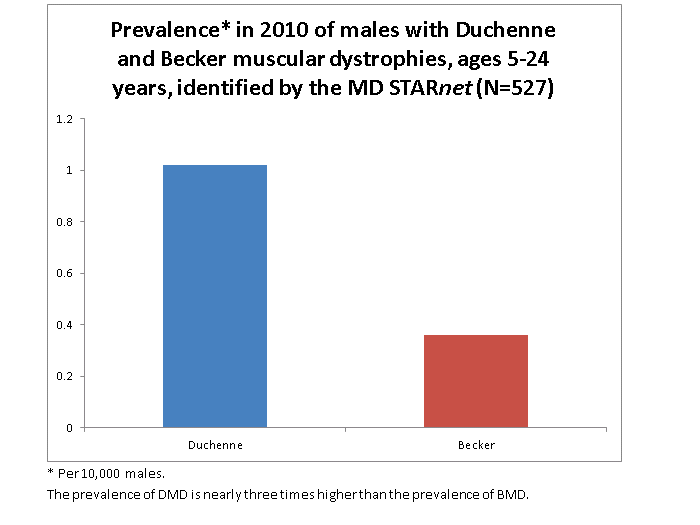Key Findings: Population-Based Prevalence of Duchenne and Becker Muscular Dystrophies in the United States

First Population-Based Prevalence on Duchenne and Becker Muscular Dystrophy in the United States by Race and Ethnicity
Researchers from the Muscular Dystrophy Surveillance, Tracking and Research Network (MD STARnet) have just published in Pediatrics the first population-based data on prevalence of Duchenne and Becker muscular dystrophies, known as DBMD, by race/ethnicity in the United States. Prevalence of DBMD is the number of people identified with DBMD compared to the total number of people in the same geographic region. MD STARnet is funded and managed by the Centers for Disease Control and Prevention (CDC).
Prevalence of DBMD in each racial and ethnic group differed across the time period studied, but overall prevalence has remained the same as previous estimates. This information is important for public health researchers who work to better understand diagnosis and care for individuals living with DBMD.
You can read a summary of the article here.
Muscular dystrophies are a group of genetic disorders that result in muscle weakness over time. The most common muscular dystrophy in children is Duchenne muscular dystrophy (DMD), which predominantly affects males. Historically, DMD has resulted in loss of the ability to walk between ages 7 and 13 years, and death in the teens or 20s. 1 Becker muscular dystrophy (BMD) is similar to DMD, but has later onset and slower, more variable progression of symptoms.
In 2009, MD STARnet researchers reported preliminary prevalence estimates for DBMD from four MD STARnet sites. 2 New research from six MD STARnet sites presents prevalence estimates for individuals with DBMD born from January 1, 1986 through December 31, 2005. Researchers also looked at differences in prevalence by age of those with DBMD in 2010, their race/ethnicity, and whether they had DMD or BMD.
Important findings from this study


Interpreting the findings
- This study provides the first population-based prevalence data in the United States for different racial and ethnic groups for Duchenne and Becker muscular dystrophies.
- In this study, prevalence estimates are based on including individuals where a positive laboratory test for DBMD or a family history of DBMD was required. Including individuals who did not fully meet the rigorous requirements of a positive laboratory test or a family history increased the prevalence estimate. Older individuals were less likely to be included under the more rigorous requirements. This may be a reflection of improvements in diagnostic testing for younger age groups and difficulty with obtaining diagnostic information from medical records for older individuals.
- These findings reflect the racial/ethnic makeup of the six MD STARnet sites – Arizona, Colorado, Iowa, Georgia, Hawaii, and 12 counties in Western New York. It does not reflect the entire population of the United States.
About the study
- MD STARnet data were collected using active identification of individuals with DBMD from a variety of data sources such as medical records, birth and death certificates, and hospital discharge records. Telephone surveys with primary caregivers supplemented the residence history information from medical records.
- Using this methodology, researchers were able to identify individuals with DBMD diagnosed from January 1982 through December 2011 and who resided in one of the six MD STARnet sites.
What you can do
Healthcare Professionals and Partners
Organizations and healthcare professionals serving the Duchenne and Becker muscular dystrophy communities may want to consider using tools targeting different racial/ethnic groups to improve access to care for these individuals.
Researchers
Ongoing public health monitoring is critical to understanding and improving the differences in diagnosis and care for individuals living with DBMD.
What CDC is doing
CDC works to improve the health and quality of life for individuals with muscular dystrophy. CDC partners with healthcare professionals, university researchers, and patient organizations to better understand muscular dystrophy. MD STARnet is the only population-based muscular dystrophy public health monitoring program in the United States. This program addresses gaps in public health research of muscular dystrophy. Future research studies may have a role in improving care for individuals and support for families and caregivers.
Resources
CDC’s muscular dystrophy homepage
Parent Project Muscular Dystrophy
Muscular Dystrophy Association
References used in this article
- Wong BL, Christopher C. Corticosteroids in Duchenne muscular dystrophy; a reappraisal. J Child Neurol 2002;17:183-90.
- Centers for Disease Control and Prevention. Prevalence of Duchenne/Becker muscular dystrophy among males aged 5-24 years- four states, 2007. MMWR Morb Mortal Wkly Rep 2009;58(40):1119-22.
Reference for Key Findings
Romitti PA, Zhu Y, Puzhankara S, James KA, Nabukera SK, Zamba GKD, Ciafaloni E, Cunniff C, Druschel CM, Mathews KD, Matthews DJ, Meaney FJ, Andrews JG, Caspers Conway KM, Fox DJ, Street N, Adams MM, Bolen J, on behalf of the MD STARnet. Prevalence of Duchenne and Becker Muscular Dystrophies in the United States. Pediatrics. 2015 March; 135(3):2014-44. [Epub 2015 Feb 16.]
- Page last reviewed: January 13, 2017
- Page last updated: February 17, 2015
- Content source:


 ShareCompartir
ShareCompartir